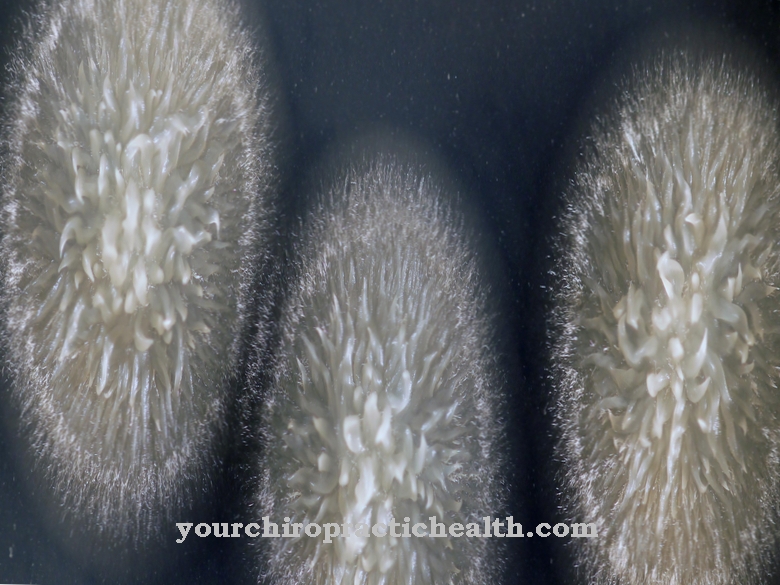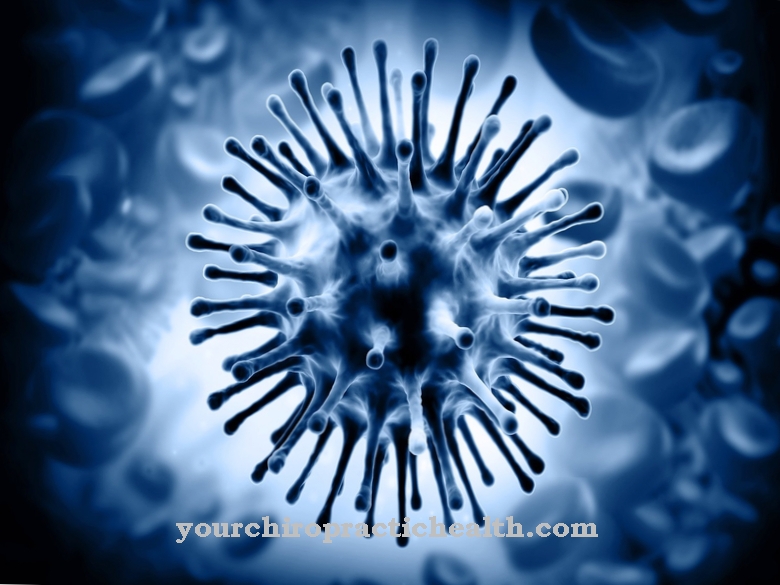Anyone who talks about a fungal infection of the skin is usually referring to athlete's foot. But there are many other areas of the body on which the microbes settle. In bad cases they have to Dermatophytes infected patients take special medication for months to heal the inflamed areas.
What are dermatophytes?
Dermatophytes are thread fungi (Hyphomycetes). The tiny microbes cause skin infections (dermatophytoses). There they nest in the upper or even lower layers of the skin and feed on the keratins of the dead skin cells. The tiny pathogens have enzymes like keratinase to break down the particles.
38 types of dermatophytes are currently known in humans and animals. They are assigned to three genera: Trichophyton, Microsporum and Epidermophyton floccosum. The vast majority of skin fungal diseases are caused by thread fungi. Most of them only affect the upper skin (epidermis). However, some specialize in nutrients found in the dermis and subcutis. As a rule, they attack parts of the body covered with horn cells. Other dermatophytes prefer the scalp and nails. Epidermophytes rarely cause fungal infections of the skin.
Occurrence, Distribution & Properties
Thread fungi occur outside of humans, in the soil and on the skin of animals. These are mostly pets (dog, cat, rodent). Since humans have particularly intensive contact with them, animal-to-human transmissions occur relatively frequently. Fungi can also be transmitted from rats and mice. Soil-to-human infections are rather rare and mostly only affect occupational groups that have frequent contact with the earth. However, wet areas in public swimming pools and saunas can also be infectious. If the visitors then do not wear flip-flops, infections often occur. In contrast, person-to-person infection occurs more frequently. It comes about through close physical contact and shared surfaces (swimming pool floor) and objects (combs, brushes).
The skin inflammation caused by the dermatophytes can take different forms depending on the type and size of the affected area of skin. With severe infestation, even large parts of the skin's protective acid mantle can be destroyed. Some hyphae attach themselves to the skin cells with the help of special adhesive devices, while other types of fungus prefer to colonize hard-to-reach areas of the body (spaces between the toes). Depending on the preferred settlement location, they have enzymes such as elastases (decompose the elastin layer of the skin), keratinases (specialize in horny scales) and collagenases (feed on collagen). Your metabolic products then cause the fungal infection (tinea).
Thread fungi not only affect the skin, but also hair and nails. Trichophytes are also found in pets and can infect nails, skin, and hair. Microsporum species also like to colonize animals that live in close contact with humans. They prefer hair and skin. Epidermophyton floccosum - if it appears at all - specializes in nails and skin.
Illnesses & ailments
Prerequisites for an infection with thread fungi are a poor condition of the skin barrier, a high degree of moisture, prolonged contact with the pathogen and the strength of the infectious potential of the fungi. There are three types of infections caused by thread fungi, depending on the area in which they spread (skin, nails and hair mycoses).
Skin mycoses (tinea corporis) show up in the form of reddened, scaly and sharply demarcated skin flowers (ring lichen) with a dark red, scaly edge that spread from the trunk. Therefore, they also occur on the arms and in the groin and anal region. Tinea corporis is caused by trichophytes and microsporum (from dogs). The efflorescences itch and spread from the inside out, whereby the metabolic products excreted by them cause a ring-shaped wall that is highly infectious. The area in it heals faster and becomes lighter and lighter.
Larger areas affected by the skin lichen also grow into one another. If there is hair on the infected areas, it usually falls out quickly. In patients with a weakened immune system, tinea corporis usually spreads over the entire body. Tinea rubrum syndrome is an infectious special form: Trichophyton rubrum, which normally only causes athlete's foot, spreads over the entire body. The syndrome occurs in families. Even the nails can be infected.
Hand fungus infections (tinea manuum) are mostly limited to members of certain professional groups such as farm workers and gardeners. They are caused by the microsporum gypseum that lives in the soil. This type of inflammation is usually confined to a single palm. It is scaly, cracked and thickened by horny layers. Nail mycoses (tinea unguium) cause brownish, brittle nails. This is due to Epidermophyton floccosum or Trichophyton species. Fungal nail infestation often occurs together with athlete's foot. The infection of the space between the toes spreads to the toenails. Nail mycoses are more common in patients with diabetes and circulatory disorders of the legs.
Athlete's foot (tinea pedis) is now estimated to affect every fifth German citizen. All three filamentous fungus genera contribute to its development, but above all Trichophyton rubrum, which is widespread in Europe.
Hair mycoses occur either on the head as tinea capitis or in the beard (tinea barbae). It is caused by trichophytes and microspores, which prefer to live on the skin of dogs. The infected areas on the scalp are circular, covered with scales and have the typical "mown meadow": The hair there is all broken off at the same height. Tinea barbae leaves bald spots that are sometimes crusty and covered with foci.

















.jpg)



.jpg)

.jpg)




